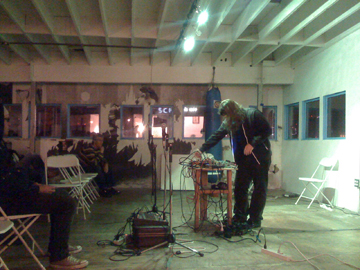Thursday, April 30, 2009
Flu inspires racism?
Tuesday, April 28, 2009
More on swine flu links to factory farms...
*****************
David Kirby
Journalist
Posted April 26, 2009 | 05:17 PM (EST)
Officials from the CDC and USDA will likely arrive in Mexico soon to help investigate the deadly new influenza virus that managed to jump from pigs to people in a previously unseen mutated form that can readily spread among humans.
One of the first things they will want to look at are the hundreds of industrial-scale hog facilities that have sprung up around Mexico in recent years, and the thousands of people employed inside the crowded, pathogen-filled confinement buildings and processing plants.
Industry calls these massive compounds "confined animal feeding operations," or CAFOs (KAY-fohs), though most people know them simply as "factory farms." You have seen them before while flying: Long white buildings lined up in tightly packed rows of three, four or more. Within each confinement, thousands of pigs are restricted to indoor pens and grain-fed for market, while breeding sows are kept in small metal crates where they spend most of their lives pregnant or nursing piglets.
In the last several years, U.S. hog conglomerates have opened giant swine CAFOs south of the border, including dozens around Mexico City in the neighboring states of Mexico and Puebla. Smithfield Foods also reportedly operates a huge swine facility in the State of Veracruz. Many of these CAFOs raise tens of thousands of pigs at a time. Cheaper labor costs and a desire to enter the Latin American market are drawing more industrialized agriculture to Mexico all the time, wiping out smaller, traditional farms, which now account for only a small portion of swine production in Mexico.
"Classic" swine flu virus (not the novel, mutated form in the news) is considered endemic in southern Mexico, while the region around the capital is classified as an "eradication area" - meaning the disease is present, and efforts are underway to control it. For some reason, vaccination of pigs against swine flu is prohibited in this area, and growers rely instead on depopulation and restriction of animal movement when outbreaks occur.
U.S. and Mexican epidemiologists and veterinarians will surely want to take swine samples from Mexican CAFOs and examine them for the newly discovered influenza strain (No one knows exactly how long it has been in circulation). And though it is too early to know if this new virus mutated and incubated on Mexican hog CAFOs, the industrialized facilities unquestionably belong on the list of suspects.
Pigs are nature's notorious "mixing bowls" for inter-species infections, and many swine flu viruses have long contained human influenza genetic components. Then, in the late 1990's - when industrialized swine production really took off in North America - scientists were alarmed to find that avian influenza genetic material was also mixed into the continent's viral soup (see below). Fortunately, it was not the dreaded and lethal H5N1 strain, which most people know of as "bird flu."
So where did this new, virulent and highly infectious influenza emerge from? According to Mexico's Health Minister, Jose Angel Cordova, the virus "mutated from pigs, and then at some point was transmitted to humans." It sure sounds like something happened on some farm, somewhere.
For years, leading scientists around the world have worried that large-scale, indoor swine "factories" would become breeding grounds for new pathogens that could more easily infect humans and then spread out rapidly in the general population - threatening to become a global pandemic.
We know that hog workers in Europe and North America are far more likely than others to be infected with potentially lethal pathogens such as MRSA (Methicillin-resistant Staphylococcus aureus), drug-resistant E. coli and Salmonella, and of course, swine influenza. Many scientists also believe that people who work inside CAFOs are more at risk of contracting and spreading these and other "zoonotic" diseases than those working in smaller-scale operations, with outdoor pens or pasture and far lower animal density.
But until now, hog workers with swine flu have rarely gone on to infect other people, save for close family members. And that is why this new strain of swine influenza virus is so vexing - and alarming. It seems to spread quite easily through casual human contact.
This new strain making headlines and killing people contains genetic components of human flu virus, avian flu virus and - for the first time ever - two types of swine flu virus: American and Eurasian. "Such a combination of components (genes) was not found so far, neither among humans nor among pigs (as far as we know)," CDC spokesman Tom Skinner said in an email.
Nobody yet knows whether the mysterious mixing of two continents' swine flu genes is what made this outbreak so deadly, and so infectious among people, but you can bet that the world's best labs are already on the case. Another possibility is that a new and more aggressive strain of avian influenza got into the new mix as well.
How could this happen? There are several plausible explanations.
A New Avian Component?
Avian influenza viral components can easily mix with swine flu virus to create new bugs - and this can happen on both traditional hog farms and inside CAFOs, scientists say.
Last year, the Pew Commission on Industrial Farm Animal Production issued a lengthy report on factory farming that included research on emerging forms of avian-swine-human influenza viruses. The molecular forensics of rapidly mutating animal pathogens makes epidemiological investigations all the more challenging, it said. "Populations exposed to infectious agents arising in CAFOs are even more difficult to define as some agents - such as a novel avian influenza virus - may be highly transmissible in or well beyond a community setting," the Pew report stated.
The transmission of avian or swine influenza viruses to humans, the report said, (almost wistfully, in retrospect), "seems a rather infrequent event today."
But the commission also issued this grave and perhaps all-too prescient warning:
The continual cycling of swine influenza viruses and other animal pathogens in large herds or flocks provides increased opportunity for the generation of novel viruses through mutation or recombinant events that could result in more efficient human-to-human transmission of these viruses. In addition, agricultural workers serve as a bridging population between their communities and the animals in large confinement facilities. This bridging increases the risk of novel virus generation in that human viruses may enter the herds or flocks and adapt to the animals.
Reassortant influenza viruses with human components have ravaged the modern swine industry. Such novel viruses not only put the workers and animals at risk of infections, but also potentially increase zoonotic disease transmission risk to the communities where the workers live. For instance, 64% of 63 persons exposed to humans infected with H7N7 avian influenza virus had serological evidence of H7N7 infection following the 2003 Netherlands avian influenza outbreak in poultry. Similarly, the spouses of swine workers who had no direct contact with pigs had increased odds of antibodies against swine influenza virus. Recent modeling work has shown that among communities where a large number of CAFO workers live, there is great potential for these workers to accelerate pandemic influenza virus transmission.
"We met with a team of researchers from the University of Iowa who are studying avian flu, and their real concern was the very scenario that may have happened in Mexico - that avian flu may get into a swine CAFO and rapidly mutate and then get passed to workers, and then on to other people very quickly," Bob Martin, who was executive director of the now-disbanded commission and currently a Senior Officer at the Pew Environmental Group, told me.
"Their concern was that new strains of avian flu combining with swine flu could make the swine flu more deadly," he said. "And because viruses pass so easily between pigs and people, the new avian component could make swine flu more virulent."
Researchers such as Gregory Gray, MD, a University of Iowa professor of international epidemiology and expert in zoonotic infections, warned that CAFO workers could serve as a "bridging population" to rural communities sharing viruses with the pigs, and vice-versa. Other scientists suggested that CAFO workers could theoretically spread disease quickly to great distances. An outbreak of infectious avian flu on the Eastern Shore of Maryland, for example, could reach the Rocky Mountains within 36 hours.
The Iowa team was also worried that CAFO production could lead to another 1918-style global pandemic. One theory behind that calamity is that waterfowl cross-infected U.S. pigs with a new type of avian-swine super-virus that was quickly transmitted to farm workers, possibly in Iowa, who went off to military training camps for WWI, and then spread the pathogen worldwide
"One very big concern was that swine flu mixed with wild bird flu, or bird flu in a chicken CAFO, tended to be ripe for incubating new types of viral infections, especially since the animals are so densely packed together," Bob Martin said.
Hog CAFOs are supposed to be completely closed environments, in order to protect the pigs from outside diseases. Visitors are usually required to shower and don special protective clothing (again, for the animals' benefit) before going inside a confinement.
But these are not hermetically sealed environments, and pathogens can enter and exit a CAFO in a number of ways other than via swine workers (or flies, another proven vector of CAFO diseases).
To begin with, some swine CAFO's recover water from their waste lagoons and recycle it back into the animal housing, in order to wash out the barns while also cutting down on dwindling groundwater supplies (a particular concern in parts of Mexico, to be sure). But wildfowl routinely land in CAFO lagoons, where they can easily shed influenza virus into the water. This can also happen at facilities that use water from nearby ponds or rivers.
Here in the U.S., the National Pork Board had already urged all producers to take a number of steps to reduce the risk of avian-to-swine influenza transmission (A new advisory has also been posted today).
"It is in the best interest of both human public health and animal health that transmission of influenza viruses from pigs to people, from people to pigs, from birds to pigs and from pigs to birds be minimized," says the group's website, Pork.org.
"The global reservoir of influenza viruses in waterfowl, the examples of infection of pigs with waterfowl-origin influenza viruses, the risks for reassortment of avian viruses with swine and/or human influenza viruses in pigs, and the risk for transmission of influenza viruses from pigs to domestic turkeys all indicate that contact between pigs and both wild and domestic fowl should be minimized," the Pork Board says. It then offers some "potentially useful" factors to "reduce transmission of influenza viruses between birds and pigs":
■ Bird-proofing - All doorways, windows and air-flow vents in swine housing units should be adequately sealed or screened to prevent entrance of birds.
■ Water treatment - Do not use untreated surface water as either drinking water or water for cleaning in swine facilities. Likewise, it may be prudent to attempt to minimize waterfowl use of farm lagoons.
■ Separation of pig and bird production - Do not raise pigs and domestic fowl on the same premises.
■ Feed security - Keep pig feed in closed containers to prevent contamination with feces from over-flying waterfowl.
■ Worker biosecurity - Provide boots for workers that are worn only within the pig housing units, thus eliminating.
Dr. Liz Wagstrom, the board's director of veterinary science, said she did not know if Mexican producers followed the same precautions, though she did note that none of the Mexican herds under US contract have reported any unusual health problems.
As for the use of surface water sources on U.S. pig farms, Wagstrom said it does happen, but her group is moving to avoid that practice industry-wide. She added that the new virus has not been detected in any U.S. pigs, and there is no importation of live swine from Mexico.
When Pig Viruses Collide
The CDC, USDA and Mexican authorities will surely focus on this previously unheard of viral "reassortment" that combines swine influenza components from both American and Eurasian strains.
Pigs don't fly, so how could this happen? One explanation, again, is the birds. Every year, more than two million wild fowl fly up to 1,500 miles or more eastward across the Arctic Ocean from Asia to North America. There, the migrating Asian birds intersect with North American species along the great north-south "flyways" of the Americas. There is sharing of viruses between bird species from both continents, UI's Dr. Gray told me.
Last October, a team from the U.S. Geological Survey published a study in Molecular Ecology that found genetic evidence of (non-H5N1) flu viruses in northern pintail ducks in Alaska whose genes were more closely related to Asian bird flu strains than those in the Americas. "Although some previous research has led to speculation that intercontinental transfer of avian influenza viruses from Asia to North America via wild birds is rare, this study challenges that," Chris Franson, a USGS wildlife biologist, told reporters.
The question, then, is could the Asian avian virus contain swine flu components from Eurasian pigs?
"Absolutely," said Ellen Silbergeld, professor of environmental health sciences at Johns Hopkins Bloomberg School of Public Health, and a leading researcher of pathogen evolution in CAFOs. "A pig infected by avian virus can then come into contact with swine virus, which then combines and gets picked up by a bird again. It's a viral patchwork. Wild birds can carry virus with swine components in it - a lot of avian viruses contain elements from pigs."
Silbergeld is by no means convinced that birds brought the Eurasian genetic material to Mexico.
"Pig's don't fly, but pork does," she said. "There is an active international transfer of all kinds of animal products, including food, food components, animal waste, offal, feed made of rendered animals and so on. Some of it is imported from Asia or Europe."
And of course, people fly, too. Dr. Silbergeld thinks that human travel is the most likely way that Eurasian swine viral components made their way to Mexico. "A tourist from China could have gone to Mexico City, and that Asian strain was picked up by somebody else, who then went to a swine barn," she suggested. "It's a likely explanation. Sometimes we overestimate what wild birds can do."
But no matter how the Eurasian strain got to Mexico, Dr. Silbergeld thinks the genetic swimming pool that is found in modern swine - or poultry - production is probably the place from whence this killer bug evolved.
"CAFOs are not biosecure," she told me. "They have high rates of ventilation and enormous number of animals that would die of heat stress unless the building was ventilated. We and others have measured bacteria and viruses in the environment around poultry and swine houses. They are carried by flies, too. These places are not bio-secure going in - or going out."
"These mixing bowls of intensive operations of chickens and pigs are contributing to speeding up viral evolution," Dr. Silbergeld added. "I think CAFOs are contributing."
But, what about traditional outdoor farms? Aren't those animals even more susceptible to wild type viruses than animals kept indoors, as industry claims? "Well, let's say that animals in confinement are ten times less likely to be infected by wild animals," she said, "But there are 100 times as many of them. You do the math."
The Pork Board's Dr. Wagstrom said her industry has been working closely with the US Government for nearly a year to set up a new monitoring and rapid animal-identification system for emerging swine flu strains in the U.S. herd. Wagstrom added that the new virus "could have" emerged from a Mexican swine CAFO, though she doesn't think birds were involved.
"Where it happened is not as important right now as locating the virus, and stopping its spread," she said. "There will be lots of epidemiology done in the future to find out where this came from."
One hopes the hard detective work will get underway as soon as humanly possible.
The author is currently completing a new book on industrial animal production for St. Martins Press.
Monday, April 27, 2009
Ok, my friends know I'm a bit germaphobic...
(Also, CorpseBoy reminded me of factory farms and their role in breeding viruses and bacteria...)
**********
Ben Sherwood
Author, Journalist, Founder and CEO of TheSurvivorsClub.org
Huffington Post
April 27, 2009 | 01:56 PM (EST)
BIO Become a Fan
Get Email Alerts Bloggers' Index
Swine Flu Survival: The Science of a Single Sneeze (and Three Simple Ways to Protect Yourself)
A single sneeze propels 100,000 droplets into the air at around 90 mph, landing on door knobs, ATM keypads, elevator buttons, escalator railings, and grocery cart handles. In a subway station at rush hour, according to British researchers, as many as 10 percent of all commuters can come in contact with the spray and residue from just one sneeze (or sternutation). That means as many as 150 commuters can be sickened by one uncovered achoo.
No wonder health officials are extremely concerned about the new strain of swine flu that has infected at least 20 Americans in five states, killed some 80 people in Mexico, and has traveled to the other side of the world in New Zealand. Understandably, US authorities - following the lead of the World Health Organization (WHO) - have declared a "public health emergency."
"This virus has, clearly, a pandemic potential," says Margaret Chan, director general of WHO. Why? The virulent new H1N1 swine flu strain spreads quickly and efficiently from human to human. It's "a completely novel virus," says the CDC (Centers for Disease Control and Prevention). This latest variant is a mixture of human virus, bird virus, and pig viruses from all over the world. Experts say it's particularly worrisome because people are getting sick without any encounters with pigs. Even worse, young, healthy people (ages 20-40) are dying at a striking rate, a telltale sign of the worst flu epidemics.
Swine flu fears aren't new in the United States. In February 1976, a 19-year-old army private at Fort Dix, New Jersey, died within 24 hours of becoming infected with swine flu. Soon, 500 soldiers were afflicted and the US government began a controversial nationwide vaccination campaign. Ultimately, some 40 million Americans were inoculated. As a result, several hundred people developed Guillain- Barré syndrome, a serious neurological condition, and the immunization program was stopped.
What's going to happen this time? Without question, the disease will spread farther and wider. At this point, as the CDC says, it can't be contained or controlled. (The flu shot from last fall, for instance, won't combat this strain).
What can you do to protect yourself? "No single action will provide complete protection," the CDC notes, but taking a few steps can help reduce the likelihood of transmission of swine flu (or many other infections).
1. Sanitize -- i.e. Wash Your Hands Frequently. It may sound obvious, but hand-washing with soap and water for around 20 seconds is the single best thing you can do (if you're going to go out into the world and interact with other human beings). The CDC estimates that 80 percent of all infections are spread by hands. If you can't wash your hands regularly, try hand-sanitizers with 60 percent alcohol content.
2. Avoid -- i.e. Engage in "Social Distancing." That's the fancy term for reducing unnecessary social contact, staying away from crowds, and avoiding people if you're sick or if you're concerned that they may be infected. It may not be especially practical when you have to go to, say, work, but experts believe it's worth repeating: Isolation and avoidance reduce your chances of getting infected or infecting others.
(Researchers in the UK - mentioned above and sponsored by a cold remedy company - found that 99 percent of commuters suffer at least one cold per winter. By contrast, 58 percent of people who work from home and 88 per cent of those who walk to work caught a cold last winter).
If you need to go someplace crowded, the CDC says, try to spend as little time as possible and try to stay six feet away from potentially infected people. Wearing a surgical or dental facemask - cleared by the FDA as a medical device - "can help prevent some exposures," the CDC says, but they're not foolproof.
3. Be Alert -- i.e. Recognize the Symptoms and Get Help. Swine flu symptoms are similar to regular flu: Fever, body aches, sore throat, cough, runny nose, vomiting, diarrhea, and lethargy. If you don't feel well, seek medical attention. So far, it's important to note, this swine flu is treatable (and absolutely survivable). It's resistant to two of four antiviral drugs approved for combating the flu: Symmetrel and Flumadine. But two newer antivirals - Tamiflu and Relenza - appear to work.
What are the chances of a global pandemic? "The situation is uncertain and unpredictable and likely to be a marathon more than a sprint," says Dr. Richard Besser, acting director of the Centers for Disease Control and Prevention.
"We expect there to be a broader spectrum of disease here in the U.S.," adds Dr. Anne Schuchat, interim deputy director for the agency's Science and Public Health Program. "I do fear that we will have deaths here."
Swine flu will dominate news headlines in the days ahead. Every case around the world will be carefully tracked and tallied -- and deservedly so. It may not sound like much, but the best defense involves some very simple steps: Every sneeze should be covered -- preferably with the crook of an arm - and every hand should be washed ... and washed again.
For more information about swine flu or surviving other kinds of life-changing adversity, please go to TheSurvivorsClub Website.
The CDC has set up a toll-free hotline: 1-800-CDC-INFO. Or check out the CDC Website.
Sunday, April 26, 2009
The Thing

Swedish saxophonist Mats Gustafsson and two Norwegians, bassist Ingebrigt Håker Flaten and drummer Paal Nilssen-Love
Friday, April 10, 2009
First session







"Maybe we shouldn't have typed 'command-a, delete' at the end of the session?" (not)
Wednesday, April 08, 2009
I love tofu...
Woman's tofu license plate curdles in Colo.
1 hr 46 mins ago
DENVER – One Colorado woman's love for tofu has been judged X-rated by state officials. Kelly Coffman-Lee wanted to tell the world about her fondness for bean curd by picking certain letters for her SUV's license plate. Her suggestion for the plate: "ILVTOFU." But the Division of Motor Vehicles blocked her plan because they thought the combination of letters could be interpreted as profane.
Says Department of Revenue spokesman Mark Couch: "We don't allow 'FU' because some people could read that as street language for sex."
Officials meet periodically to ensure state plates stay free of letters that abbreviate gang slang, drug terms or obscene phrases.
The 38-year-old Coffman-Lee says tofu is a staple of her family's diet because they are vegan and that the DMV misinterpreted her message.
Monday, April 06, 2009
Great Weekend...!
What a great weekend. Besides getting a lot of work done in the studio mixing Jeff Denson's album, I had friends visiting to play gigs. Steuart Liebig, Bill Barret, Tony Atherton and Joe Berardi (The Mentones) played Spring Reverb here, as did Hans Fjellestad. Then PLOTZ! and Andrew Durkin's Industrial Jazz Group ended their tour at Dizzy's last night. Kris Tiner drove in after their LA gig Saturday night, and we had a great hang Sunday. He hipped me to more iPhone apps that I knew existed that I now NEED. Including, this screen cleaner.
On to the photos:


George Lewis, David Borgo, and Miss Hubbard. We had a great talk about Sun Ra and the AACM and George extended some of the ideas in his book, which is a great read. While you're there, check out David's book, which is also a wonderful read. Both books are insightful and thought-provoking, as well as engaging reads.

Hans Fjellestad played a beautiful, gritty, bone-grinding set. I do believe some of the sounds he developed during the gig cause calcium depletion. I had a great hang after with Borgo, Bill Barrett and Hans at the Aero Club. Turns out Hans has a taste for the single malts, and they had some decent one's on hand.

The Mentones: Joe Berardi, Steuart Liebig, Tony Atherton, Bill Berardi burning down Kava Lounge.


The Industrial Jazz Group played a great set at Dizzy's. Andrew Durkin rocked the place, and in addition to the great music, there were an array of costumes and non-costumes. (For an example of "non-costume," see the clothes challenged trombonist Mike Richardson on the right.)
Saturday, April 04, 2009
Friday, April 03, 2009
Thank you, Stephen Colbert...
| The Colbert Report | Mon - Thurs 11:30pm / 10:30c | |||
| The 10.31 Project | ||||
| comedycentral.com | ||||
| ||||
Thursday, April 02, 2009
Microsoft...
Wednesday, April 01, 2009
Odd food...for me...
From the AP:
Warning sought for burger the size of your head
AP
Wed Apr 1, 1:25 am ET
GRAND RAPIDS, Mich. – The West Michigan Whitecaps say they have no plans to put a warning label on an enormous new hamburger they're selling this season — despite a vegan advocacy group's request to do just that.
Susan Levin, a staff dietitian for the Washington-based Physicians Committee for Responsible Medicine, sent a letter to the Grand Rapids minor-league team on Tuesday. She's asking that the 4,800-calorie burger be labeled a "dietary disaster" that increases the risk of cancer and heart disease.
The 4-pound, $20 burger features five beef patties, five slices of cheese, nearly a cup of chili and liberal doses of salsa and corn chips — all on an 8-inch bun.
Whitecaps spokesman Mickey Graham says the burger is a gimmick that's being promoted as a very unhealthy menu item.
*************
AND food links for your enjoyment:
http://www.porktopia.com/2009/03/porkgasm.html

